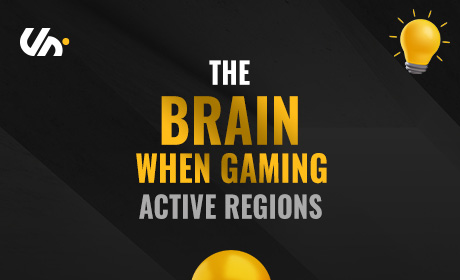Copyright @ 2023
26 Jun

The Gaming Brain: Active Regions
In our article on Gamification, we discussed gamification from a Psychological Perspective. Now, we will go even deeper and delve into what is actually happening inside the Brain when you press that Spin button. In this first article on our series of how the brain reacts to games, we will cover which anatomical regions activate and why?
Buckle up, you’re in for a brainy ride!
Active Regions of the Brain
Let’s start by breaking down the different areas of the brain which start lighting up when gambling during an fMRI scan (functional Magnetic Resonance Imaging). As you can imagine, Risk and Loss Aversion are two of the key areas being utilized by your brain. However, it is far from the only one..
Our understanding of the Human Brain is still very limited, but research shows there are six clear regions doing a large amount of work when Gambling. It is in general the areas linked to Risk, Fear, Attention, Reward Anticipation, Decision-making, Memory and Planning. More specifically they are:
The Ventromedial Prefrontal Cortex (vmPFC) is located in the frontal lobe and implicated in processing Risk and Fear. It regulates the Amygdalae, plays a role in the inhibition of emotional responses and in the process of exhibiting self-control. Remember when you wanted to get out of that poker hand because something inside you told you it was a bad idea to call?
The Amygdala are two clusters of nuclei deep inside the temporal lobes. Research has shown the Amygdala to perform a primary role in Memory, Decision Making and Emotional Response (incl. Fear, Anxiety, and Aggression). This area of the brain does not want you to gamble. It will try to get you away using memories and emotions to get you to stop.
Striatum is a critical component of the Brain’s reward system and functionally, it is involved in Action Planning, Decision Making, Motivation and Reinforcement. Basically, this region tries to motivate you to Gamble and then rewards you for doing it.
Dorsolateral Prefrontal Cortex (dlPFC) is in charge of the executive functions of the brain. This includes Planning, Inhibition and Abstract Reasoning. This one will logically try to get you to understand that gambling is a bad idea. Alcohol works well in shutting down the dlPFC, thus removing your inhibitions. Free drinks at the Casino anyone?
Anterior Cingulate Cortex (ACC) appears to play a role in both autonomic functions such as heart rate and blood pressure, as well as higher level functions such as Reward Anticipation and Impulse Control. When you land those two scatters and the reels start spinning faster in anticipation of the third, that’s when the ACC kicks into high gear. It is the same thing when you are playing in a Unibo mission and trying to get the third win in a row to finish your mission.
The Insula is a portion of the Cerebral cortex believed to be involved in consciousness and play a role in functions linked to emotion and the regulation of the body conditions. So next time you are gambling and you feel your palms sweating, that’s the Insula doing its magic.
So how do these six areas of the brain do it? How do they get you to Gamble and make sure you enjoy it? The answer is, as always, Drugs! (Well, “Neurochemical Systems” if you want to get technical). We’ll cover this in the next article in our series. Stay tuned for more.